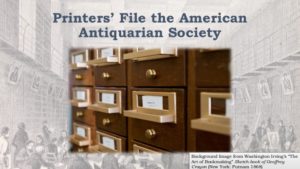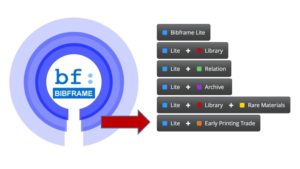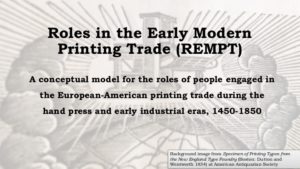I’ve just returned from a visit to the British Library, where, in true antiquarian fashion, I couldn’t help but pretend to be Washington Irving’s Geoffrey Crayon learning the “Art of Bookmaking” and studying the “very act of manufacturing books.” In reality (though not unrelatedly), I was there to partake in a meeting with other institutions working with legacy data related to people in the printing trade from 1450 to 1850. These prosopographies, or mini-biographies, of people’s lives in and around the book trade were largely collected in the twentieth century, and we are all working hard to make them interoperable in the twenty-first. 
A continuation of conversations first begun in 2014 in Oxford at the “Mapping the British Book Trade” conference, this meeting gave me a great chance to update this group about what’s new with AAS’s Printers’ File. This project aims to make available a unique set of data on the printing trade in what is now the United States from first printing in 1640 through 1820.  This information set, which was created in the middle of the twentieth century on index cards, has already been transformed into data, thanks to a group of assiduous summer staffers last year (read about their work here and here) and generous support from the Delmas Foundation. With more generous support from the Pine Tree Foundation and the Lapidus Digital Fund at AAS, we then partnered with Zepheira to transform the data into BIBFRAME, the library standard for Linked Open Data. The Early Printing Trade vocabulary builds on the BIBFRAME Lite vocabulary to support the description of people involved in all parts of the printing trades in the hand press and early steam press periods. The Printers’ File data now exists in a backend framework on Library.Link Network. Please find the data there, but know that it is not yet easy to search or extract. That’s what’s coming!
This information set, which was created in the middle of the twentieth century on index cards, has already been transformed into data, thanks to a group of assiduous summer staffers last year (read about their work here and here) and generous support from the Delmas Foundation. With more generous support from the Pine Tree Foundation and the Lapidus Digital Fund at AAS, we then partnered with Zepheira to transform the data into BIBFRAME, the library standard for Linked Open Data. The Early Printing Trade vocabulary builds on the BIBFRAME Lite vocabulary to support the description of people involved in all parts of the printing trades in the hand press and early steam press periods. The Printers’ File data now exists in a backend framework on Library.Link Network. Please find the data there, but know that it is not yet easy to search or extract. That’s what’s coming!
 The Printers’ File project’s next phase is to make this data and its structures available by creating the Printers’ File Online (PFO), a front-end user interface to query, extract, and enhance the data.We will also develop an ontology to describe the complex relationships between people, their occupations, and the objects they produced. The Roles in the Early Modern Printing Trade (REMPT) ontology will render the Printers’ File data interoperable with preexisting large, international data sets related to print production in the hand press and early industrial printing periods. Formed in conjunction with partners at Oxford’s Bodleian Libraries, the Consortium of European Research Libraries (CERL), and the Stationers’ Register Online, REMPT will also pave the way for future projects interested in creating such data sets.
The Printers’ File project’s next phase is to make this data and its structures available by creating the Printers’ File Online (PFO), a front-end user interface to query, extract, and enhance the data.We will also develop an ontology to describe the complex relationships between people, their occupations, and the objects they produced. The Roles in the Early Modern Printing Trade (REMPT) ontology will render the Printers’ File data interoperable with preexisting large, international data sets related to print production in the hand press and early industrial printing periods. Formed in conjunction with partners at Oxford’s Bodleian Libraries, the Consortium of European Research Libraries (CERL), and the Stationers’ Register Online, REMPT will also pave the way for future projects interested in creating such data sets.
I went to the British Library to update the group on the developments of the Printers’ File, not as my imagination directed me: to ogle “a body of magi, deeply engaged in the study of occult sciences,” as Irving’s Crayon does. In the course of the meeting, I heard updates about a number of related projects that capture the lives of those involved in the early modern printing trades. These projects are at various phases of development, but it is still worth sharing these amazing research resources:
- Anette Hagan presented on the Scottish Book Trade Index hosted by CERL, but compiled and maintained by the National Library of Scotland. This index lists the names, trades, and addresses of people involved in printing in Scotland up to 1850, including printers, publishers, booksellers, bookbinders, printmakers, stationers, and papermakers.
- Giles Bergel then presented on the British Book Trade Index, a resource that has, in the course of its relatively long history, moved from Newcastle upon Tyne to Birmingham, and is now maintained by the Bodleian at Oxford. The BBTI, as it is commonly known, includes brief biographical and trade details of all those who worked in the English and Welsh book trades up to 1851.
- Neil Jefferies spoke about the London Book Trade Index, which is currently under development by the Bodleian. This index was compiled from former Bodleian Head of Special Collections Michael Turner who entered all of this data into an Access database that he would share with friends and other libraries. Jefferies spoke of the use of Semantic Media Wiki to make the data more widely accessible; this platform allows for the concurrence of structured and unstructured data.
- Ian Gadd updated us on his work with Giles Bergel to create the Stationers’ Register Online, which is neither a database of books or people, but instead of copyright claims. The SRO, as it will be known, is forthcoming by the end of the year. In the meantime, you can learn about the project here.
- Justin Tonra ended the discussion with details of plans for the Irish Book Trade Index. This resource is still largely aspirational, but there is much enthusiasm for it. Its sources will be former Trinity College Dublin (TCD) Keeper of Early Printed Books Mary “Paul” Pollard’s Dictionary of Members of the Dublin Book Trade, 1550-1800, as well the extension of Pollard’s work into the nineteenth century by Charles Benson, retired keeper of rare books and special collections at TCD.
This meeting was an excellent chance to exchange ideas and share plans for linking these vast sets of biographical data on what Lisa Maruca has termed the “protagonists of print.” I look forward to thinking more about how the Printers’ File project and prosopographies generally can relate to bibliographic data on the “Digital Histories of the Book in America” panel at the Modern Language Association in New York in January 2018. The panel will feature the exciting work Jacqueline Goldsby and Meredith McGill have been doing on black bibliography, as well Mike Kelly’s work with the astounding Kim-Wait/Eisenberg Collection at Amherst College.
